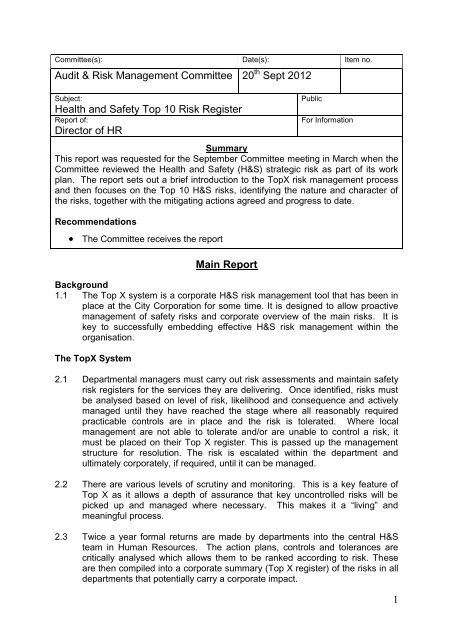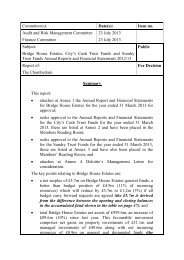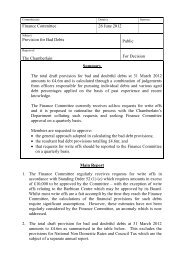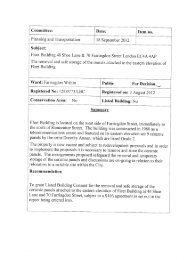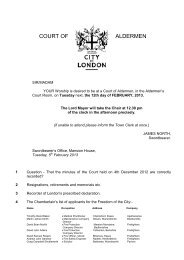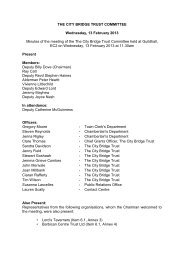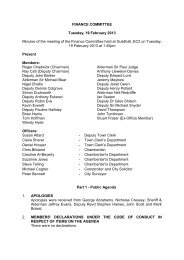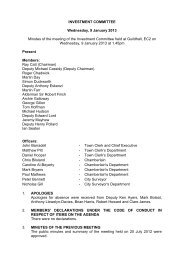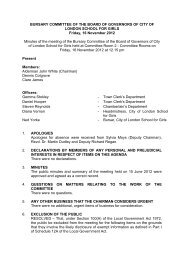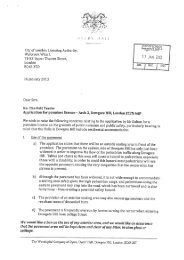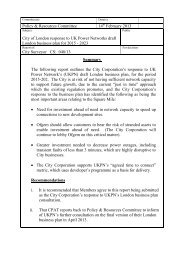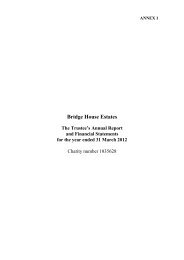Health and Safety - Top 10 Risk Register PDF 232 KB
Health and Safety - Top 10 Risk Register PDF 232 KB
Health and Safety - Top 10 Risk Register PDF 232 KB
Create successful ePaper yourself
Turn your PDF publications into a flip-book with our unique Google optimized e-Paper software.
Committee(s): Date(s): Item no.<br />
Audit & <strong>Risk</strong> Management Committee 20 th Sept 2012<br />
Subject:<br />
<strong>Health</strong> <strong>and</strong> <strong>Safety</strong> <strong>Top</strong> <strong>10</strong> <strong>Risk</strong> <strong>Register</strong><br />
Report of:<br />
Director of HR<br />
Public<br />
For Information<br />
Summary<br />
This report was requested for the September Committee meeting in March when the<br />
Committee reviewed the <strong>Health</strong> <strong>and</strong> <strong>Safety</strong> (H&S) strategic risk as part of its work<br />
plan. The report sets out a brief introduction to the <strong>Top</strong>X risk management process<br />
<strong>and</strong> then focuses on the <strong>Top</strong> <strong>10</strong> H&S risks, identifying the nature <strong>and</strong> character of<br />
the risks, together with the mitigating actions agreed <strong>and</strong> progress to date.<br />
Recommendations<br />
The Committee receives the report<br />
Main Report<br />
Background<br />
1.1 The <strong>Top</strong> X system is a corporate H&S risk management tool that has been in<br />
place at the City Corporation for some time. It is designed to allow proactive<br />
management of safety risks <strong>and</strong> corporate overview of the main risks. It is<br />
key to successfully embedding effective H&S risk management within the<br />
organisation.<br />
The <strong>Top</strong>X System<br />
2.1 Departmental managers must carry out risk assessments <strong>and</strong> maintain safety<br />
risk registers for the services they are delivering. Once identified, risks must<br />
be analysed based on level of risk, likelihood <strong>and</strong> consequence <strong>and</strong> actively<br />
managed until they have reached the stage where all reasonably required<br />
practicable controls are in place <strong>and</strong> the risk is tolerated. Where local<br />
management are not able to tolerate <strong>and</strong>/or are unable to control a risk, it<br />
must be placed on their <strong>Top</strong> X register. This is passed up the management<br />
structure for resolution. The risk is escalated within the department <strong>and</strong><br />
ultimately corporately, if required, until it can be managed.<br />
2.2 There are various levels of scrutiny <strong>and</strong> monitoring. This is a key feature of<br />
<strong>Top</strong> X as it allows a depth of assurance that key uncontrolled risks will be<br />
picked up <strong>and</strong> managed where necessary. This makes it a “living” <strong>and</strong><br />
meaningful process.<br />
2.3 Twice a year formal returns are made by departments into the central H&S<br />
team in Human Resources. The action plans, controls <strong>and</strong> tolerances are<br />
critically analysed which allows them to be ranked according to risk. These<br />
are then compiled into a corporate summary (<strong>Top</strong> X register) of the risks in all<br />
departments that potentially carry a corporate impact.<br />
1
2.4 The summary is presented to the H&S Committee (a senior officer <strong>and</strong><br />
employee representative group which meet twice a year in May <strong>and</strong><br />
November to consider H&S risks <strong>and</strong> activities at a corporate level) who can<br />
review, examine <strong>and</strong> initiate work streams as necessary to ensure safety risks<br />
are proactively managed or tolerated. Chief Officer Group (COG) will also<br />
have regular visibility of this list <strong>and</strong> be able to track progress. Immediate<br />
action is taken by the corporate safety team as new risks are identified.<br />
2.5 See Appendix A for the current corporate safety risk register. The information<br />
is tabulated for ease <strong>and</strong> allows the risks to be tracked from each reporting<br />
period tracking the risk’s movement; depending on controls implemented by<br />
the department. It also presents the overall risk factor <strong>and</strong> severity through the<br />
use of a quantitative scoring system <strong>and</strong> a colour coding for the risk tolerance.<br />
2.6 It is important to note that the <strong>Top</strong>X H&S process mirrors the risk<br />
management framework as per the <strong>Risk</strong> Management H<strong>and</strong>book. Some of<br />
the mechanisms differ due to the specific nature of safety <strong>and</strong> the clear<br />
legislative drivers behind issues but as a process it provides a corporate<br />
consistency to our overall risk management processes, <strong>and</strong> has resulted in<br />
the mitigation of a number of complex risks, please see paragraph 3.1 iii <strong>and</strong> x<br />
for some examples.<br />
Current <strong>Top</strong> <strong>10</strong> Corporate <strong>Risk</strong>s<br />
3.1 This sets out the risks as at the last review in May 2012 (next one due<br />
November 2012). All the risks have the potential for serious harm. Many of<br />
the risks have been controlled <strong>and</strong> are due to come off the list at the next<br />
review, (noted below <strong>and</strong> in Appendix A).<br />
Fire <strong>Risk</strong> in Buildings<br />
i. This was a dynamic risk identified within Community <strong>and</strong> Children’s Services<br />
as a result of maintenance work which identified poor quality contractor work<br />
in a particular residential block. An emergency work programme was put in<br />
place to rectify the issues, which has been completed <strong>and</strong> has received formal<br />
sign off by the relevant Local Authority Building Control Officer. A separate<br />
risk, in the same residential block, was identified in that the wireless alarm<br />
system had “wireless blind spots”. This matter has been resolved, with a<br />
further recommendation that when the alarm system is replaced in the spring<br />
of 2013, that this be done with a “hard wired” rather than a “wireless” system.<br />
Reservoir Works<br />
ii. This risk covers the works required to large retained water bodies across all<br />
Open Spaces; most particularly but not exclusively Hampstead Heath <strong>and</strong><br />
Epping Forest. The Hampstead Heath flood <strong>and</strong> water quality project is an<br />
element of this risk. It covers issues such as the danger of overtopping, dam<br />
failure <strong>and</strong> flooding; resulting in destruction of property, serious injury or<br />
deaths. This requires input at the corporate level with control of contractors<br />
<strong>and</strong> community <strong>and</strong> stakeholder consultation <strong>and</strong> engagement. Stakeholder<br />
consultations have commenced at both Epping <strong>and</strong> Hampstead. Committee<br />
authorisation has been obtained for the appointment of specialist consultants<br />
2
<strong>and</strong> design teams. For Hampstead, appointments will be finalised in October,<br />
presentations by potential Strategic L<strong>and</strong>scape Architects have been made to<br />
the stakeholders <strong>and</strong> further investigations regarding other potentially affected<br />
l<strong>and</strong>owners are on-going.<br />
Fire <strong>and</strong> Evacuation<br />
iii. This risk was identified by the Barbican Centre. With the redundancy of the<br />
fire safety team, a new process needed to be introduced before their<br />
departure to effectively manage fire evacuations. A new process has been<br />
agreed <strong>and</strong> customer experience staff trained. A test exercise was<br />
successfully carried out. The Customer Experience Team are now fully<br />
operational <strong>and</strong> directly managing the Fire <strong>Safety</strong> Systems for the Centre <strong>and</strong><br />
Exhibition Halls. The last part of the process was completed mid-August.<br />
Monitoring of performances, activations, on-going training <strong>and</strong> drills will<br />
continue by the Customer Experience Management Team supported by the<br />
Centre's Fire Management Team. This risk will now come off the Corporate<br />
<strong>Top</strong> X.<br />
Fire <strong>Risk</strong> in Residential Blocks<br />
iv. This was a proactive review by Community <strong>and</strong> Children’s Services of fire risk<br />
based on incidents in other authorities. There were no issues identified. This<br />
risk will now come off the Corporate <strong>Top</strong> X.<br />
Building Maintenance<br />
v. Identified by the City Surveyor’s Department, this risk focuses on ensuring<br />
contractors are competent <strong>and</strong> complying with legal requirements. The<br />
department have now engaged 2 main contractors for Building Repairs <strong>and</strong><br />
Lift Maintenance, replacing our existing 350+ contractors. They are also<br />
putting in place Frameworks to cover projects <strong>and</strong> construction which will<br />
have pre-vetted suppliers. This has reduced the risk of ensuring our<br />
contractors are competent in complying with legal requirements. Those<br />
specialist contractors, projects <strong>and</strong> construction that fall outside of pre-vetted<br />
instructions, will be included in a new policy that will include vetting procedure<br />
<strong>and</strong> the control of contractors for day to day on site management, including<br />
the following; permits to work, risk assessments, method statements, <strong>and</strong> safe<br />
working. The policy is due to be published at the beginning of October.<br />
Police H&S <strong>Risk</strong><br />
vi. The City Police identified a risk which will is covered by an appendix in the<br />
non-public agenda.<br />
Work at Heights<br />
vii. This risk was identified by the Markets <strong>and</strong> Consumer Protection department.<br />
It relates to maintenance, installation <strong>and</strong> general repairs using ladders,<br />
portable towers etc. <strong>and</strong> roof working. Control measures agreed include<br />
ensuring that safety lines are repainted <strong>and</strong> investigation of a safety system<br />
for the roof of one market, ensuring that all contractors comply with the<br />
requirements of permits to work, rescue plans completed where required <strong>and</strong><br />
2 person working for all high risk work. This is currently being managed <strong>and</strong><br />
risk-reduced across the department <strong>and</strong> we believe that these measures now<br />
3
mean that, although it remains a risk, all reasonable measures have been<br />
taken.<br />
Event Management<br />
viii. This matter was raised by Remembrancer’s <strong>and</strong> covered a range of potential<br />
scenarios including breaches of security , food hygiene issues, inadequate<br />
3rd party risk assessments <strong>and</strong> improper evacuation of guests <strong>and</strong> staff at<br />
events. Mitigating actions include liaising with the Security Superintendent<br />
<strong>and</strong> risks assessing all events. Raising awareness of evacuation procedures,<br />
<strong>and</strong> providing additional training where necessary, ensuring Environmental<br />
Services continue with rigorous checks of caterers, <strong>and</strong> developing a checklist<br />
for outside venues. There has been the recent view of evacuation procedures<br />
<strong>and</strong> a protocol has been developed with Surveyor's (who lead) which has<br />
resolved the issue.<br />
Fire at Buildings<br />
ix. This was identified as a risk by the City Police (CoLP) in relation to a number<br />
of potential fire hazards across the Force estate. A fire safety audit <strong>and</strong> risk<br />
assessments for CoLP buildings have been completed <strong>and</strong> all<br />
recommendations have been actioned. All officers <strong>and</strong> staff are required to<br />
undertake fire safety training <strong>and</strong> compliance is monitored at Directorate <strong>and</strong><br />
Force H&S meetings. Since March 2012 an additional 47 staff have<br />
completed this training. There is weekly testing of fire alarms <strong>and</strong><br />
Directorates conduct local H&S inspections which includes checks on fire<br />
safety equipment. The fire alarm system at Snow Hill has been upgraded with<br />
new control panel, sensors <strong>and</strong> strobe lighting as an alternative warning<br />
mechanism for deaf staff members. Installation of new power cables for the<br />
Comm<strong>and</strong> <strong>and</strong> Control Room at Wood Street has been completed which has<br />
allowed further shut down <strong>and</strong> testing of electrical systems to be undertaken.<br />
Traffic Management<br />
x. This was a risk identified by the Markets <strong>and</strong> Consumer Protection<br />
department. It relates to the movement of cars, lorries <strong>and</strong> Fork Lift Trucks<br />
(FLTs) in common parts. A number of agreed actions include; a review of<br />
signage <strong>and</strong> lighting, regular maintenance of pedestrian walkway <strong>and</strong> road<br />
markings, enforcement of site speed limits, a review <strong>and</strong> enforcement of a<br />
new FLT penalty point scheme, assisting the tenants in developing safer<br />
unloading practices, <strong>and</strong> engaging them to ensure they meet their H&S<br />
responsibilities, proposal of traffic calming measures. The FLT strategy was<br />
signed off as effective by the HSE (<strong>Health</strong> <strong>and</strong> <strong>Safety</strong> Executive) at<br />
Spitalfields when reviewed as part of an investigation. This risk will now come<br />
off the Corporate <strong>Top</strong> X.<br />
4. Conclusion<br />
4.1 The <strong>Top</strong> X register gives the City Corporation a mechanism for safety risk<br />
management at all levels, <strong>and</strong> has been used to good effect. It allows the City<br />
Corporation to demonstrate a proactive process to complement the wider<br />
safety management system <strong>and</strong> practically helps to ensure that foreseeable<br />
risks do not go unmanaged. Importantly it sends a strong message on safety<br />
4
leadership throughout the organisation <strong>and</strong> helps to foster a positive safety<br />
culture whilst demonstrating proactive safety management at the senior<br />
corporate management level.<br />
Appendices<br />
Appendix A – The Corporate <strong>Safety</strong> <strong>Risk</strong> <strong>Register</strong> - May 2012<br />
Contact:<br />
Oliver San<strong>and</strong>res | oliver.san<strong>and</strong>res@cityoflondon.gov.uk | 0207 332 3307<br />
Nicky Johnson | nicky.johnson@cityoflondon.gov.uk | 0207 332 3148<br />
5


